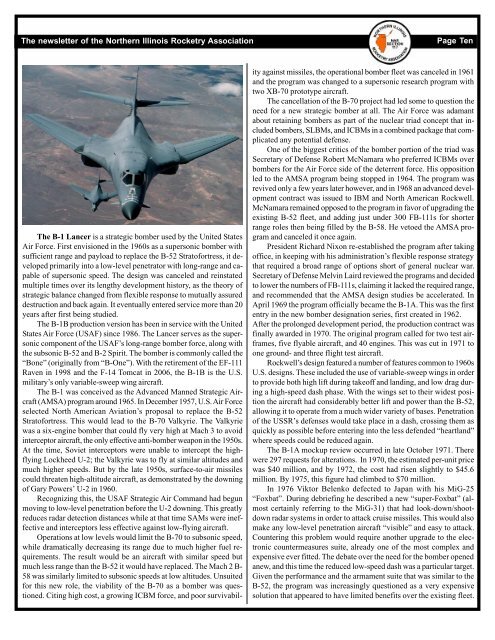The newsletter of the Northern Illinois Rocketry AssociationPage TenThe B-1 Lancer is a strategic bomber used by the United StatesAir Force. First envisioned in the 1960s as a supersonic bomber withsufficient range and payload to replace the B-52 Stratofortress, it developedprimarily into a low-level penetrator with long-range and capableof supersonic speed. The design was canceled and reinstatedmultiple times over its lengthy development history, as the theory ofstrategic balance changed from flexible response to mutually assureddestruction and back again. It eventually entered service more than 20years after first being studied.The B-1B production version has been in service with the UnitedStates Air Force (USAF) since 1986. The Lancer serves as the supersoniccomponent of the USAF’s long-range bomber force, along withthe subsonic B-52 and B-2 Spirit. The bomber is commonly called the“Bone” (originally from “B-One”). With the retirement of the EF-111Raven in 1998 and the F-14 Tomcat in 2006, the B-1B is the U.S.military’s only variable-sweep wing aircraft.The B-1 was conceived as the Advanced Manned Strategic Aircraft(AMSA) program around 1965. In December 1957, U.S. Air Forceselected North American Aviation’s proposal to replace the B-52Stratofortress. This would lead to the B-70 Valkyrie. The Valkyriewas a six-engine bomber that could fly very high at Mach 3 to avoidinterceptor aircraft, the only effective anti-bomber weapon in the 1950s.At the time, Soviet interceptors were unable to intercept the highflyingLockheed U-2; the Valkyrie was to fly at similar altitudes andmuch higher speeds. But by the late 1950s, surface-to-air missilescould threaten high-altitude aircraft, as demonstrated by the downingof Gary Powers’ U-2 in 1960.Recognizing this, the USAF Strategic Air Command had begunmoving to low-level penetration before the U-2 downing. This greatlyreduces radar detection distances while at that time SAMs were ineffectiveand interceptors less effective against low-flying aircraft.Operations at low levels would limit the B-70 to subsonic speed,while dramatically decreasing its range due to much higher fuel requirements.The result would be an aircraft with similar speed butmuch less range than the B-52 it would have replaced. The Mach 2 B-58 was similarly limited to subsonic speeds at low altitudes. Unsuitedfor this new role, the viability of the B-70 as a bomber was questioned.Citing high cost, a growing ICBM force, and poor survivabilityagainst missiles, the operational bomber fleet was canceled in 1961and the program was changed to a supersonic research program withtwo XB-70 prototype aircraft.The cancellation of the B-70 project had led some to question theneed for a new strategic bomber at all. The Air Force was adamantabout retaining bombers as part of the nuclear triad concept that includedbombers, SLBMs, and ICBMs in a combined package that complicatedany potential defense.One of the biggest critics of the bomber portion of the triad wasSecretary of Defense Robert McNamara who preferred ICBMs overbombers for the Air Force side of the deterrent force. His oppositionled to the AMSA program being stopped in 1964. The program wasrevived only a few years later however, and in 1968 an advanced developmentcontract was issued to IBM and North American Rockwell.McNamara remained opposed to the program in favor of upgrading theexisting B-52 fleet, and adding just under 300 FB-111s for shorterrange roles then being filled by the B-58. He vetoed the AMSA programand canceled it once again.President Richard Nixon re-established the program after takingoffice, in keeping with his administration’s flexible response strategythat required a broad range of options short of general nuclear war.Secretary of Defense Melvin Laird reviewed the programs and decidedto lower the numbers of FB-111s, claiming it lacked the required range,and recommended that the AMSA design studies be accelerated. In<strong>April</strong> 1969 the program officially became the B-1A. This was the firstentry in the new bomber designation series, first created in 1962.After the prolonged development period, the production contract wasfinally awarded in 1970. The original program called for two test airframes,five flyable aircraft, and 40 engines. This was cut in 1971 toone ground- and three flight test aircraft.Rockwell’s design featured a number of features common to 1960sU.S. designs. These included the use of variable-sweep wings in orderto provide both high lift during takeoff and landing, and low drag duringa high-speed dash phase. With the wings set to their widest positionthe aircraft had considerably better lift and power than the B-52,allowing it to operate from a much wider variety of bases. Penetrationof the USSR’s defenses would take place in a dash, crossing them asquickly as possible before entering into the less defended “heartland”where speeds could be reduced again.The B-1A mockup review occurred in late October 1971. Therewere 297 requests for alterations. In 1970, the estimated per-unit pricewas $40 million, and by 1972, the cost had risen slightly to $45.6million. By 1975, this figure had climbed to $70 million.In 1976 Viktor Belenko defected to Japan with his MiG-25“Foxbat”. During debriefing he described a new “super-Foxbat” (almostcertainly referring to the MiG-31) that had look-down/shootdownradar systems in order to attack cruise missiles. This would alsomake any low-level penetration aircraft “visible” and easy to attack.Countering this problem would require another upgrade to the electroniccountermeasures suite, already one of the most complex andexpensive ever fitted. The debate over the need for the bomber openedanew, and this time the reduced low-speed dash was a particular target.Given the performance and the armament suite that was similar to theB-52, the program was increasingly questioned as a very expensivesolution that appeared to have limited benefits over the existing fleet.
The newsletter of the Northern Illinois Rocketry AssociationPage ElevenDuring the 1976 federal election campaign, Jimmy Carter made it oneof the Democratic Party’s platforms, saying “The B-1 bomber is anexample of a proposed system which should not be funded and wouldbe wasteful of taxpayers’ dollars.”When Carter took office in 1977 he ordered a review of the entireprogram. By this point the projected cost of the program had risen toover $100 million per aircraft, although this was lifetime cost over 20years. He was informed of the relatively new work on stealth aircraftthat had started in 1975, and decided that this was a far better avenueof approach. Pentagon officials also stated that the ALCM (AirLaunched Cruise Missile) launched from the existing B-52 fleet wouldgive the USAF equal capability of penetrating Soviet airspace. A programto improve the B-52 and develop and deploy the ALCM wouldcost perhaps 20% of the price to deploy the planned 244 B-1As.On 30 June 1977 Carter announced that the B-1A would be canceledin favor of ICBMs, SLBMs, and a fleet of modernized B-52sarmed with ALCMs. Flight tests of the four B-1A prototypes for theB-1A program continued through <strong>April</strong> 1981. The program included70 flights totalling 378 hours. A top speed of Mach 2.22 was reachedby the second B-1A. Engine testing also continued during this timewith the YF101 engines totalling almost 7,600 hoursIt was during this period that the Soviets, also acting in proxythrough Cuba, started to exert themselves in several new theaters ofaction, in particular the Cuban support in Angola starting in 1975 andthe Soviet invasion of Afghanistan in 1979. The U.S. strategy to thispoint was containment and a conventional and nuclear war in Europe,which almost all military planning had been focused on. These neweractions revealed that the military was simply incapable of supportingany sort of effort outside these narrow confines.During the 1980 presidential campaign, Ronald Reagan campaignedheavily on the platform that Carter was weak on defense, usingthe cancellation of the B-1 program as a prime example. Duringthis time Carter’s defense secretary, Harold Brown, announced thestealth bomber project, apparently implying that this was the reasonfor the B-1 cancellation. Brown later denied this claim, stating Carterwas simply opposed to any military buildup.On taking office, Reagan was faced with the same decision asCarter before; whether to continue with the B-1 for the short term, orto wait for the development of the ATB, a much more advanced aircraft.He decided to do both. Air Force studies suggested that the existingB-52 fleet with ALCM would remain a credible threat until1985 , as it was predicted that 75% of the B-52 force would survive toattack its targets. After this period the introduction of the SA-10 missile,MiG-31 interceptor and the first Soviet AWACS systems wouldmake them increasingly vulnerable.During the FY81 budget funds were given to a new study for abomber for the 1990s time-frame. These studies led to the Long-RangeCombat Aircraft (LRCA) project which compared the B-1, F-111 andATB as possible solutions. An emphasis was placed on the designbeing multi-role, as opposed to a purely strategic weapon. At the timeit was believed the B-1 could be in operation before the B-2, coveringthe time period between the B-52s increasing vulnerability and theintroduction of the ATB. Reagan decided the best solution was to purchaseboth the B-1 and ATB, and this eventually led to Reagan’s 2October 1981 announcement that a new version of the B-1 was beingordered to fill the LRCA role.Numerous changes were made to the design to better fit it to realworldmissions, resulting in the new B-1B. These changes included areduction in maximum speed, which allowed the variable-aspect intakeramps to be replaced by simpler fixed geometry intake ramps inthe newer design. This reduced the B version’s radar signature becausethe compressor faces of the engines, major radar reflectors, wouldbe partially hidden. Low-altitude speed was somewhat improved, fromabout Mach 0.85 to 0.92. This left the B-1B with the capability forspeeds of about Mach 1.25 “at altitude”, a reduction from the B-1A’sMach 2 performance.Opposition to the plan was widespread within Congress. Criticspointed out that many of the original problems with the concept remained.In particular it seemed the B-52 fitted with electronics similarto the B-1B would be equally able to avoid interception, as thespeed advantage of the B-1 was now minimal. It also appeared that the“interim” time frame served by the B-1B would be less than a decade,being rendered obsolete shortly after introduction by the much morecapable ATB design. The primary argument in favor of the B-1 was itslarge conventional payload, and that its takeoff performance allowedit to operate with a credible bombload from a much wider variety ofairfields. The debate remained rancorous. But the Air Force very astutelyspread production subcontracts across many congressional districts,making the aircraft more popular on Capitol Hill.The first production model of the revised B-1B first flew in October1984, and the first B-1B, “The Star of Abilene”, was deliveredto Dyess Air Force Base, Abilene, Texas, in June 1985, with initialoperational capability on 1 October, 1986. The 100th and final B-1Bwas delivered 2 May 1988.The B-1 has a blended wing body configuration, with variablesweepwing, triangular fin control surfaces and four turbofan engines,to improve range and speed with enhanced survivability. Forward-sweptwing settings are used for takeoff, landings and high-altitude maximumcruise. Aft-swept wing settings are used in high subsonic andsupersonic flight. The length of the aircraft presented a serious flexingproblem due to air turbulence at low altitude. To alleviate this,Rockwell included small canards near the nose on the B-1. An accelerometerwould actuate the canards automatically to counteract turbulenceand smooth out the ride.Unlike the B-1A, the B-1B made no attempt at Mach 2+ speeds.Its maximum speed at altitude is Mach 1.25, but its low-level speedincreased to Mach 0.92.Operationally, the B-1 was first used in combat in support ofoperations against Iraq during Operation Desert Fox in December 1998.B-1s have been subsequently used in Operation Allied Force (Kosovo)and most notably in Operation Enduring Freedom in Afghanistan andthe 2003 invasion of Iraq.The B-1 now fills an important niche in the Air Force inventory.With the arrival of limited numbers of B-2s in the 1990s and the continuinguse of B-52s, its value has been questioned. However, the capabilityof a high-speed strike with a large bomb payload for timesensitiveoperations is useful, and no new strategic bomber is on theimmediate horizon.A total of 100 B-1Bs were produced with 93 bombers remainingin 2000 after losses in accidents. Copied from Wikipedia



